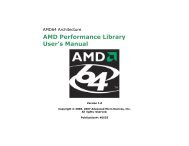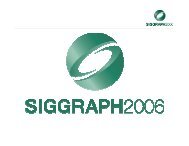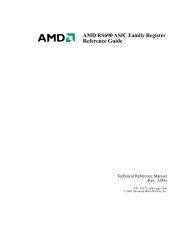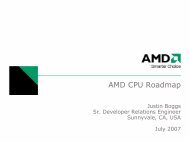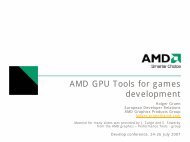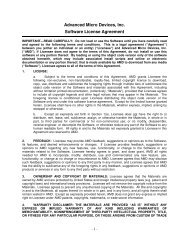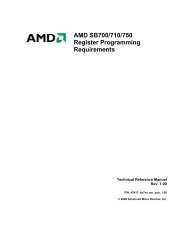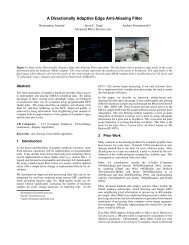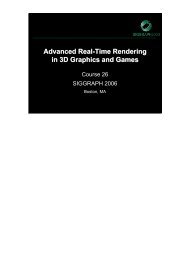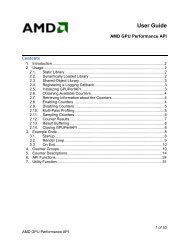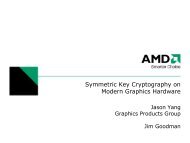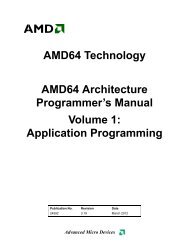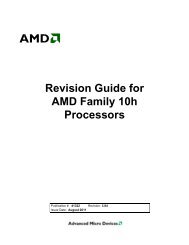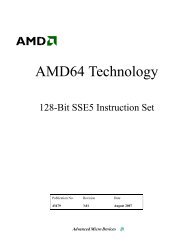AMD 780G Family BIOS Developer's Guide - AMD Developer Central
AMD 780G Family BIOS Developer's Guide - AMD Developer Central
AMD 780G Family BIOS Developer's Guide - AMD Developer Central
You also want an ePaper? Increase the reach of your titles
YUMPU automatically turns print PDFs into web optimized ePapers that Google loves.
<strong>AMD</strong> <strong>780G</strong> <strong>Family</strong><br />
<strong>BIOS</strong> <strong>Developer</strong>’s <strong>Guide</strong><br />
For the RS780, RS780C, RS780D, RS780M,<br />
RS780E, RS780MC, and RX781<br />
Technical Reference Manual<br />
Rev. 1.01<br />
P/N: 43734_rs780_bdg_pub_1.01<br />
© 2009 Advanced Micro Devices, Inc.
Trademarks<br />
<strong>AMD</strong>, the <strong>AMD</strong> Arrow logo, <strong>AMD</strong> Athlon, ATI, Mobility, PowerPlay, CrossFire, Radeon, and combinations thereof, are trademarks of Advanced Micro Devices, Inc.<br />
HyperTransport is a licensed trademark of the HyperTransport Technology Consortium.<br />
Microsoft and Windows are registered trademarks of Microsoft Corporation.<br />
Other product names used in this publication are for identification purposes only and may be trademarks of their respective companies.<br />
Disclaimer<br />
The contents of this document are provided in connection with Advanced Micro Devices, Inc. ("<strong>AMD</strong>") products. <strong>AMD</strong> makes no representations or warranties with respect<br />
to the accuracy or completeness of the contents of this publication and reserves the right to make changes to specifications and product descriptions at any time without notice.<br />
No license, whether express, implied, arising by estoppel, or otherwise, to any intellectual property rights are granted by this publication. Except as set forth in <strong>AMD</strong>'s Standard<br />
Terms and Conditions of Sale, <strong>AMD</strong> assumes no liability whatsoever, and disclaims any express or implied warranty, relating to its products including, but not limited to, the<br />
implied warranty of merchantability, fitness for a particular purpose, or infringement of any intellectual property right.<br />
<strong>AMD</strong>'s products are not designed, intended, authorized or warranted for use as components in systems intended for surgical implant into the body, or in other applications<br />
intended to support or sustain life, or in any other application in which the failure of <strong>AMD</strong>'s product could create a situation where personal injury, death, or severe property or<br />
environmental damage may occur. <strong>AMD</strong> reserves the right to discontinue or make changes to its products at any time without notice.<br />
© 2009 Advanced Micro Devices, Inc. All rights reserved.
Chapter 1: Introduction<br />
Table of Contents<br />
1.1 About This Document.........................................................................................................................................................1-1<br />
1.2 Architecture Overview........................................................................................................................................................1-1<br />
Chapter 2: Register Space Access<br />
2.1 PCIE Core/Port Indirect Register Space (PCIEIND)..........................................................................................................2-1<br />
2.2 PCIE Port Indirect Register Space (PCIEIND_P) ..............................................................................................................2-1<br />
2.3 HTIU Indirect Register Space (HTIUIND) ........................................................................................................................2-1<br />
2.4 MISC Indirect Register Space (MISCIND) ........................................................................................................................2-1<br />
2.5 Clock Configuration Register Space (CLKCONFIG) ........................................................................................................2-2<br />
Chapter 3: IRQ Mapping<br />
3.1 Integrated GFX ...................................................................................................................................................................3-1<br />
3.2 PCIE Ports...........................................................................................................................................................................3-1<br />
Chapter 4: UMA Size Consideration<br />
4.1 UMA/System Memory Size................................................................................................................................................4-1<br />
Chapter 5: CIMX RS780 Architecture<br />
5.1 Introduction.........................................................................................................................................................................5-1<br />
5.2 Distribution Model..............................................................................................................................................................5-1<br />
5.3 Integration and Usage Model..............................................................................................................................................5-1<br />
5.4 Flow Chart...........................................................................................................................................................................5-2<br />
5.5 Binary File...........................................................................................................................................................................5-3<br />
5.5.1 Overview ..............................................................................................................................................................5-3<br />
5.5.2 Binary Header.......................................................................................................................................................5-3<br />
5.6 CIM Interface Calls Environment ......................................................................................................................................5-4<br />
5.7 Interface Definition .............................................................................................................................................................5-4<br />
5.7.1 Northbridge Power-On/Reset Initialization..........................................................................................................5-4<br />
5.7.2 Northbridge HT Initialization...............................................................................................................................5-5<br />
5.7.3 Northbridge PCIE Early Initialization..................................................................................................................5-6<br />
5.7.4 Northbridge Start Post Initialization...................................................................................................................5-11<br />
5.7.5 Northbridge Mid-Post Initialization ...................................................................................................................5-15<br />
5.7.6 Northbridge PCIE Late Post Initialization .........................................................................................................5-16<br />
5.7.7 Northbridge Late Post Initialization ...................................................................................................................5-16<br />
5.7.8 Northbridge PCIE S3 Resume Initialization ......................................................................................................5-16<br />
5.7.9 Northbridge S3 resume Initialization .................................................................................................................5-17<br />
5.8 Call Back Interface Definition ..........................................................................................................................................5-17<br />
5.8.1 PCIE OEM Call Back “CIMCB_PCIE_SLOT_RESET_DEASSERT” ............................................................5-17<br />
5.8.2 PCIE OEM Call Back “CIMCB_PCIE_SLOT_RESET_ASSERT” .................................................................5-17<br />
5.8.3 PCIE OEM Call Back “CIMCB_PCIE_SLOT_RESET_SUPPORT”...............................................................5-18<br />
5.8.4 PCIE OEM Call Back ”CIMCB_PCIE_TRAINING_COMPLETE” ................................................................5-18<br />
5.8.5 NB OEM Call Back ”CIMCB_NB_UMA_STATE”.........................................................................................5-18<br />
5.8.6 NB OEM Call Back ”CIMCB_NB_GET_V<strong>BIOS</strong>”...........................................................................................5-19<br />
5.8.7 NB OEM Call Back ”CIMCB_NB_UPDATE_INTEGRATED_INFO” ..........................................................5-19<br />
5.8.8 NB OEM Call Back “CIMCB_NB_DDI_COMMEN”......................................................................................5-19<br />
5.9 Integrated Info Table.........................................................................................................................................................5-20<br />
© 2009 Advanced Micro Devices, Inc. <strong>AMD</strong> <strong>780G</strong> <strong>Family</strong> <strong>BIOS</strong> <strong>Developer</strong>’s <strong>Guide</strong> 1.01<br />
Table of Contents-1
Table of Contents<br />
5.9.1 Overview............................................................................................................................................................ 5-20<br />
5.9.2 Voltage Control ................................................................................................................................................. 5-20<br />
5.10 Example (Northbridge HT Initialization)....................................................................................................................... 5-20<br />
Chapter 6: SurroundView Feature<br />
6.1 SurroundView Feature (Dual Display) .............................................................................................................................. 6-1<br />
Chapter 7: Power Management<br />
7.1 Cx State Power Management ............................................................................................................................................. 7-1<br />
7.2 Sx State Power Management............................................................................................................................................. 7-1<br />
7.2.1 Register Restoration............................................................................................................................................. 7-1<br />
7.2.2 Resume from S3 State ......................................................................................................................................... 7-2<br />
7.3 S3 PCIe Graphics BAR Save/Restore Issue Workaround ................................................................................................. 7-2<br />
7.3.1 BAR Restoration Process and Architecture......................................................................................................... 7-2<br />
7.3.2 Post Time............................................................................................................................................................. 7-2<br />
7.3.3 When Entering S3................................................................................................................................................ 7-3<br />
7.3.4 When Resuming from S3..................................................................................................................................... 7-3<br />
Appendix A: Revision History<br />
<strong>AMD</strong> <strong>780G</strong> <strong>Family</strong> <strong>BIOS</strong> <strong>Developer</strong>’s <strong>Guide</strong> 1.01 © 2009 Advanced Micro Devices, Inc.<br />
Table of Contents-2
List of Figures<br />
List of Figures<br />
Figure 5-1: Integration And Usage Model ..................................................................................................................................... 5-1<br />
Figure 5-2: RS780 Flow Chart ....................................................................................................................................................... 5-2<br />
Figure 5-3: CIMX-RS780 Binary File Format ............................................................................................................................... 5-3<br />
© 2009 Advanced Micro Devices, Inc. <strong>AMD</strong> <strong>780G</strong> <strong>Family</strong> <strong>BIOS</strong> <strong>Developer</strong>’s <strong>Guide</strong> 1.01<br />
List of Figures-1
List of Tables<br />
List of Tables<br />
Table 3-1: Integrated GFX Device Bit Setting ................................................................................................................................3-1<br />
Table 3-2: PCIE Ports Device Bit Setting .......................................................................................................................................3-1<br />
Table 4-1: UMA/System Memory Size ..........................................................................................................................................4-1<br />
Table 5-1: CIM File Header Definition ...........................................................................................................................................5-3<br />
Table 5-2: Northbridge Power-On/Reset Initialization ...................................................................................................................5-4<br />
Table 5-3: htConfiguration ..............................................................................................................................................................5-5<br />
Table 5-4: clmcConfiguration .........................................................................................................................................................5-6<br />
Table 5-5: eConfiguration ...............................................................................................................................................................5-8<br />
Table 5-6: lConfiguration ................................................................................................................................................................5-8<br />
Table 5-7: PortFeatures[11] ............................................................................................................................................................5-9<br />
Table 5-8: GPPConfig ...................................................................................................................................................................5-10<br />
Table 5-9: GFXConfig ..................................................................................................................................................................5-10<br />
Table 5-10: nbConfiguration .........................................................................................................................................................5-12<br />
Table 5-11: gfxConfiguration ........................................................................................................................................................5-12<br />
Table 5-12: spConfiguration .........................................................................................................................................................5-13<br />
Table 5-13: CState .........................................................................................................................................................................5-14<br />
© 2009 Advanced Micro Devices, Inc. <strong>AMD</strong> <strong>780G</strong> <strong>Family</strong> <strong>BIOS</strong> <strong>Developer</strong>’s <strong>Guide</strong> 1.01<br />
List of Tables-1
1.1 About This Document<br />
Chapter 1<br />
Introduction<br />
This manual contains guidelines for the <strong>BIOS</strong> and software development of a system that utilizes the <strong>AMD</strong> <strong>780G</strong> family<br />
of northbridges. Unless indicated otherwise, the programming information in this document applies to the following <strong>780G</strong><br />
variants:<br />
• RS780 (<strong>AMD</strong> <strong>780G</strong>)<br />
• RS780C (<strong>AMD</strong> 780V)<br />
• RS780D (<strong>AMD</strong> 790GX)<br />
• RS780E (<strong>AMD</strong> 780E)<br />
• RS780M (<strong>AMD</strong> M<strong>780G</strong>)<br />
• RS780MC (<strong>AMD</strong> M780V)<br />
• RX781 (<strong>AMD</strong> M770)<br />
Changes and additions to the previous release of this document are highlighted in red. Refer to Appendix A at the end of<br />
this document for a detailed revision history.<br />
1.2 Architecture Overview<br />
The RS780 is a high performance system logic chip that supports the simultaneous operation of two external PCI Express<br />
graphics cards on an <strong>AMD</strong> Sempron/Athlon 64/Athlon 64 FX/Rev 10/Rev 11 platform. It supports a four-lane PCI<br />
Express interface to the <strong>AMD</strong> IXP, as well as six ports for external PCI Express devices.<br />
<strong>AMD</strong>’s RS780 provides a bridge between HyperTransport and PCI Express. Both HyperTransport and PCI Express are<br />
point-to-point connections. Using point-to-point connections allows much higher bandwidth since the electrical design<br />
can be controlled much better than that with a shared bus (such as PCI). From a software perspective both HyperTransport<br />
and PCI Express are software compatible with PCI configuration mechanisms.<br />
© 2009 Advanced Micro Devices, Inc. 43734 <strong>AMD</strong> <strong>780G</strong> <strong>Family</strong> <strong>BIOS</strong> <strong>Developer</strong>’s <strong>Guide</strong> 1.01<br />
1-1
This page is left blank intentionally.<br />
Architecture Overview<br />
43734 <strong>AMD</strong> <strong>780G</strong> <strong>Family</strong> <strong>BIOS</strong> <strong>Developer</strong>’s <strong>Guide</strong> 1.01 © 2009 Advanced Micro Devices, Inc.<br />
1-2
2.1 PCIE Core/Port Indirect Register Space (PCIEIND)<br />
Chapter 2<br />
Register Space Access<br />
The Core Index Space contains control and status registers that are generic to all PCIE ports in the RS780. This register<br />
space is accessed through the following index/data register pair located in the RS780’s northbridge PCI configuration<br />
registers:<br />
• Index register is bus 0, device 0, register 0xE0.<br />
• Data register is bus 0, device 0, register 0xE4.<br />
Note: Register descriptions are referenced with the name PCIEIND.<br />
The Core Index Space is subdivided into two parts. Since there are a total of 3 PCIE cores in the RS780, hardware has<br />
been implemented to provide a mechanism to access these registers either independently or jointly through the<br />
programming of bits [18:16] of the index register 0xE0. The encoding is as follows:<br />
• 0xE0[18:16] == 0x1: Reads and writes accesses to 0xE4 will be directed at the per-core index registers in<br />
PCIE-GPPSB only.<br />
• 0xE0[18:16] == 0x2: Reads and writes accesses to 0xE4 will be directed at the per-core index registers in PCIE-GPP<br />
only.<br />
• 0xE0[18:16] == 0x0: Reads and writes accesses to 0xE4 will be directed at the per-core index registers for<br />
PCIE-GFX only.<br />
Note: Register descriptions are referenced with the name PCIEIND or BIFNB.<br />
2.2 PCIE Port Indirect Register Space (PCIEIND_P)<br />
This register space is accessed through the following index/data register pair located in the RS780’s northbridge PCI<br />
configuration registers:<br />
• Index register is bus 0, device 2/3/4/5/6/7/9/10, register 0xE0[15..0].<br />
• Data register is bus 0, device 2/3/4/5/6/7/9/10, register 0xE4[31..0].<br />
Note: Register descriptions are referenced with the name PCIEIND_P or BIFNBP.<br />
2.3 HTIU Indirect Register Space (HTIUIND)<br />
This register space is accessed through the following index/data register pair located in the RS780’s northbridge PCI<br />
configuration registers:<br />
• Index register is bus 0, device 0, register 0x94[7..0].<br />
• Data register is bus 0, device 0, register 0x98[31..0]. To write HTIUIND, register 0x94[8] has to be set.<br />
Note: Register descriptions are referenced with the name HTIUIND.<br />
2.4 MISC Indirect Register Space (MISCIND)<br />
This register space is accessed through the following index/data register pair located in the RS780’s northbridge PCI<br />
configuration registers:<br />
• Index register is bus 0, device 0, register 0x60[7..0].<br />
• Data register is bus 0, device 0, register 0x64[31..0]. To write MISCIND, register 0x60[7] has to be set.<br />
Note: Register descriptions are referenced with the name MISCIND.<br />
© 2009 Advanced Micro Devices, Inc. 43734 <strong>AMD</strong> <strong>780G</strong> <strong>Family</strong> <strong>BIOS</strong> <strong>Developer</strong>’s <strong>Guide</strong> 1.01<br />
2-1
2.5 Clock Configuration Register Space (CLKCONFIG)<br />
Clock Configuration Register Space (CLKCONFIG)<br />
The RS780 clock control block is located in Device0, Function1. By default, this PCI function does not appear in the PCI<br />
configuration space. System firmware can make Device0, Function1 visible by setting NBCONFIG:0x4C[0] to 1. The<br />
expected use of the Clock Control function is to only enable it in the PCI configuration space for modification by system<br />
firmware during POST. This function does not implement PCI device and vendor ID’s. Therefore, system firmware<br />
should hide the Clock Control function after making modifications.<br />
43734 <strong>AMD</strong> <strong>780G</strong> <strong>Family</strong> <strong>BIOS</strong> <strong>Developer</strong>’s <strong>Guide</strong> 1.01 © 2009 Advanced Micro Devices, Inc.<br />
2-2
3.1 Integrated GFX<br />
Table 3-1 Integrated GFX Device Bit Setting<br />
3.2 PCIE Ports<br />
Table 3-2 PCIE Ports Device Bit Setting<br />
Device Device Bit Setting<br />
5 INTA -> INTC<br />
Device Device Bit Setting<br />
2 INTA -> INTC<br />
3 INTA -> INTD<br />
4 INTA -> INTA<br />
5 INTA -> INTB<br />
6 INTA -> INTC<br />
7 INTA -> INTD<br />
9 INTA -> INTB<br />
10 INTA -> INTC<br />
Chapter 3<br />
IRQ Mapping<br />
© 2009 Advanced Micro Devices, Inc. 43734 <strong>AMD</strong> <strong>780G</strong> <strong>Family</strong> <strong>BIOS</strong> <strong>Developer</strong>’s <strong>Guide</strong> 1.01<br />
3-1
This page is left blank intentionally.<br />
PCIE Ports<br />
43734 <strong>AMD</strong> <strong>780G</strong> <strong>Family</strong> <strong>BIOS</strong> <strong>Developer</strong>’s <strong>Guide</strong> 1.01 © 2009 Advanced Micro Devices, Inc.<br />
3-2
4.1 UMA/System Memory Size<br />
Table 4-1 contains the UMA/System Memory size information for the RS780.<br />
Table 4-1 UMA/System Memory Size<br />
Chapter 4<br />
UMA Size Consideration<br />
System Memory UMA Size<br />
Under 256MB 32MB<br />
256MB ~ 512MB 64MB<br />
512MB ~ 1GB 128MB<br />
Above 1GB 256MB<br />
© 2009 Advanced Micro Devices, Inc. 43734 <strong>AMD</strong> <strong>780G</strong> <strong>Family</strong> <strong>BIOS</strong> <strong>Developer</strong>’s <strong>Guide</strong> 1.01<br />
4-1
This page is left blank intentionally.<br />
UMA/System Memory Size<br />
43734 <strong>AMD</strong> <strong>780G</strong> <strong>Family</strong> <strong>BIOS</strong> <strong>Developer</strong>’s <strong>Guide</strong> 1.01 © 2009 Advanced Micro Devices, Inc.<br />
4-2
5.1 Introduction<br />
Chapter 5<br />
CIMX RS780 Architecture<br />
The CIMX-RS780 introduces new interface and distribution model to help quickly integrate RS780 Northbridge family<br />
support in the customer products.<br />
5.2 Distribution Model<br />
To avoid miscellaneous build issues and simplify integration with different <strong>BIOS</strong> code bases CIMX-RS780 distributed in<br />
form of binary files called “B1” and “B2”. B1 contain minimum initialization required for <strong>BIOS</strong> recovery. B2 contain<br />
full chipset initialization code.<br />
5.3 Integration and Usage Model<br />
B1 image must be integrated in boot block part of the <strong>BIOS</strong> in uncompressed form to ensure possibility of recovery if the<br />
main bios image is corrupted. There are no restrictions on B2 location. B2 image integrated in main <strong>BIOS</strong> is in<br />
uncompressed form.<br />
<strong>BIOS</strong><br />
Boot Block<br />
Main <strong>BIOS</strong><br />
Post, S3 resume<br />
CIM Interface Calls<br />
B1 validate B2 integrity<br />
and call same interface in<br />
B2 if B2 valid.<br />
CIM Interface Calls<br />
CIMX-RS780 B1 Image<br />
CIMX-RS780 B2 Image<br />
Figure 5-1 Integration And Usage Model<br />
Boot Block <strong>BIOS</strong> image<br />
Main <strong>BIOS</strong> image<br />
© 2009 Advanced Micro Devices, Inc. 43734 <strong>AMD</strong> <strong>780G</strong> <strong>Family</strong> <strong>BIOS</strong> <strong>Developer</strong>’s <strong>Guide</strong> 1.01<br />
5-1
5.4 Flow Chart<br />
Memory detection.<br />
System <strong>BIOS</strong> shadowing<br />
CIMX-RS780<br />
Notrhbridge Start Post Initialization<br />
SB CIMX - AtiSbBeforePciInit<br />
PCI enumeration and resource allocation<br />
CIMX-RS780<br />
Notrhbridge Mid Post Initialization<br />
Video <strong>BIOS</strong> call<br />
SB CIMX - AtiSbAfterPciInit<br />
Cnfigure all IO device.<br />
Enumerate USB.<br />
Detect and initialize all boot devices.<br />
Initialize and execute Option ROM.<br />
<strong>BIOS</strong> setup, etc<br />
CIMX-RS780<br />
Norhbridge late Post initialization<br />
No<br />
CIMX-RS780<br />
Norhbridge PCIE late Post initialization<br />
No<br />
Power on Reset<br />
SB CIMX POR Init<br />
CIMX-RS780<br />
Notrhbridge Power On Initialization<br />
HT Initialization (AGESA)<br />
CIMX-RS780<br />
Notrhbridge HT Initialization<br />
Warm Reset Required ?<br />
Is S3 Resume<br />
Operatin System<br />
Figure 5-2 RS780 Flow Chart<br />
Restore Memory Controller<br />
Restore PCI Device configuration space<br />
Misc. Restore CPU<br />
CIMX-RS780<br />
Norhbridge S3 initialization<br />
Misc <strong>BIOS</strong> restore.<br />
Give control to OS<br />
Flow Chart<br />
43734 <strong>AMD</strong> <strong>780G</strong> <strong>Family</strong> <strong>BIOS</strong> <strong>Developer</strong>’s <strong>Guide</strong> 1.01 © 2009 Advanced Micro Devices, Inc.<br />
5-2<br />
Yes<br />
Yes<br />
SB CIMX - AtiSbBfPciRestore<br />
SB CIMX - AtiSbAfPciRestore<br />
CIMX-RS780<br />
Norhbridge PCIE S3 initialization
Binary File<br />
5.5 Binary File<br />
5.5.1 Overview<br />
The CIMX-RS780 binary file is modified and rebased in 32-bit PE32 executable generated by Microsoft Visual Studio.<br />
(For additional information about Microsoft Visual Studio file format refer “Visual Studio, Microsoft Portable Executable<br />
and Common Object File Format Specification”). Figure 5-3 illustrates the difference between Microsoft PE executable<br />
format and the CIMX-RS780 binary file format.<br />
5.5.2 Binary Header<br />
MS-DOS 2.0 Compatible<br />
EXE Header<br />
OEM Identifier<br />
OEM Information<br />
Offset to PE Header<br />
MS-DOS 2.0 Stub Program<br />
and<br />
Relocation Table<br />
PE Header<br />
Section Headers<br />
Raw Data:<br />
Code<br />
Data<br />
debug info<br />
relocations<br />
Figure 5-3 CIMX-RS780 Binary File Format<br />
The CIMX-RS780 consists of a file header followed immediately by Raw Code and Data.<br />
Table 5-1 CIM File Header Definition<br />
CIMX- RS780 Binary<br />
CIM Header<br />
Raw Data:<br />
Code<br />
Data<br />
Offset Size Field Description<br />
0 4 Signature Signature that identifies this as a CIM module.<br />
4 4 EntryPointAddress<br />
Address of the entry point relevant to the beginning of the binary<br />
image.<br />
8 4 ModuleSignature Signature that identify this particular CIM module.<br />
12 4 ImageSize Size in number of bytes of complete binary including the header.<br />
16 2 ModuleVersion Version of the binary module.<br />
18 1 Checksum Checksum of the binary image.<br />
19 5 Reserved Space reserved for future use.<br />
© 2009 Advanced Micro Devices, Inc. 43734 <strong>AMD</strong> <strong>780G</strong> <strong>Family</strong> <strong>BIOS</strong> <strong>Developer</strong>’s <strong>Guide</strong> 1.01<br />
5-3
5.6 CIM Interface Calls Environment<br />
Prior to calling any CIMX interface, it is required that the following steps are performed:<br />
• Step 1: Place CPU into 32-bit protected mode.<br />
• Step 2: Set CS as 32-bit code segment with Base/Limit – 0x00000000/0xffffffff.<br />
• Step 3: Set DS/ES/SS as 32-bit data segment with Base/Limit – 0x00000000/0xffffffff.<br />
See section 5.10 for a programming example.<br />
5.7 Interface Definition<br />
All interface calls to the CIMX-RS780 binary are C-like calls to the Entry Point of the binary image:<br />
void (*ImageEntryPointPtr)(void* Config)<br />
5.7.1 Northbridge Power-On/Reset Initialization<br />
CIM Interface Calls Environment<br />
Upon system power-on, or cold reset, the RS780 is supposed to be self-initialized to a working state without any software<br />
interference. However, the CIM may need to program the recommended settings for the purpose of enabling special<br />
functions and performance improvement during early initialization.<br />
Functions Documentation:<br />
void (*ImageEntryPointPtr)(STDCFG * Config)<br />
Detail Description:<br />
stdHeader: Standard function call<br />
stdHeader.Func = 0x1<br />
typedef struct _STDCFG{<br />
UINT32 pImageBase;<br />
UINT32 pPcieBase;<br />
UINT8 Func;<br />
UINT32 pCallBack;<br />
UINT32 pB2ImageBase;<br />
}STDCFG;<br />
pImageBase: Physical 32bit address of binary image location.<br />
pPcieBase: Address of PCIE Extended configuration space MMIO. It is required that the PCIE MMIO range be<br />
programmed in the CPU Memory Mapped IO Base/Limit Registers.<br />
Table 5-2 Northbridge Power-On/Reset Initialization<br />
Bit Field Description<br />
[0..7] PCIE Extended Configuration size Size of PCIE extended config space in MB. 0 – 256M for backward compatibility.<br />
[31..20]<br />
Example:<br />
PCIE Extended Configuration Base [31..20] of PCIE extended configuration base address.<br />
0xE0000000 – PCIE extended Cfg. MMIO 0xE0000000 – 0xEFFFFFFF (256MB)<br />
0xE0000040 – PCIE extended Cfg. MMIO 0xE0000000 – 0xE3FFFFFF (64MB)<br />
Func: Function identifier.<br />
pCallBack: Address of OEM call back function.<br />
pB2ImageBase: Optional parameter. Physical 32bit address of “B2” image location.<br />
43734 <strong>AMD</strong> <strong>780G</strong> <strong>Family</strong> <strong>BIOS</strong> <strong>Developer</strong>’s <strong>Guide</strong> 1.01 © 2009 Advanced Micro Devices, Inc.<br />
5-4
Interface Definition<br />
5.7.2 Northbridge HT Initialization<br />
The RS780 requires additional initialization for HT3 support Interface call which needs to be executed prior to applying<br />
link speed and width, but after HT link is speed/width fully configured on the northbridge and the CPU side.<br />
Functions Documentation:<br />
void (*ImageEntryPointPtr)(HTCFG* Config)<br />
Parameters:<br />
typedef struct _HTCFG{<br />
STDCFG stdHeader;<br />
UINT32 htConfiguration;<br />
void* DebugPtr;<br />
UINT32 Status;<br />
UINT32 htConfiguration;<br />
UINT8 ParentNodeLinkID;<br />
UINT8 ParentNodeSubLinkID;<br />
UINT32 clmcConfiguration;<br />
UINT16 HTRefClkMhZ;<br />
UINT16 Reserved1;<br />
UINT64 Reserved2;<br />
UINT64<br />
}HTCFG;<br />
Reserved3;<br />
Detail Description:<br />
stdHeader: Standard function call (see STDCFG definition)<br />
stdHeader.Func = 0x2.<br />
htConfiguration: HT miscellaneous configuration options.<br />
Table 5-3 htConfiguration<br />
Bit Field Description<br />
[0..1] LSx<br />
[2..3] LVM<br />
[4..5] HT3ProtocolChecker<br />
RX HT Link Power management mode<br />
0 – Auto. Recommended<br />
1 – L1s<br />
2 – L2s<br />
3 – Disable<br />
Low voltage mode<br />
0 - Auto. Recommended<br />
1 - Disable<br />
2 - Enable<br />
Set to Enable if platform support voltage scaling<br />
HT Protocol checker<br />
0 – Auto. Recommended<br />
1 – Disable<br />
2 – Enable<br />
Debug option.<br />
[6..7] LinkTristate<br />
Link tristate<br />
0 – Auto. Recommended<br />
1 – Disable<br />
[8..9] Reserved Reserved for future use. Should be set to 0.<br />
[10..11] Reserved Reserved for future use. Should be set to 0.<br />
TX HT Link Power management mode<br />
0 – Auto. Recommended<br />
[12..13] TxLSx<br />
1 – L1s<br />
2 – L2s<br />
3 – Disable<br />
© 2009 Advanced Micro Devices, Inc. 43734 <strong>AMD</strong> <strong>780G</strong> <strong>Family</strong> <strong>BIOS</strong> <strong>Developer</strong>’s <strong>Guide</strong> 1.01<br />
5-5
Table 5-3 htConfiguration<br />
Bit Field Description<br />
[14..16] XbarMode<br />
CPU XBAR optimization specific to RS780<br />
[0] – 1/0 Master bit Optimization enable/disable<br />
[1] – 1/0 Optimize for Uma/NonUma<br />
[2] – 1: CPU MCLK = 400mhz and HT Speed > 1400MhZ<br />
0: All other case. (Applicable only for GR CPU).<br />
[17..31] Reserved Reserved for future use. Should be set to 0.<br />
ParentNodeLinkID: Parent node HT Link ID to which RS780 is connected (0,1,2,3)<br />
ParentNodeSubLinkID: Parent node HT Sub Link ID to which RS780 is connected:<br />
(0,1) If the link is unganged.<br />
(0) If the link is ganged.<br />
clmcConfiguration: CLMC miscellaneous configuration options<br />
Table 5-4 clmcConfiguration<br />
Bit Field Description<br />
[0] CDLC<br />
[1] CDLD<br />
[2] CDLW<br />
[3] CDLF<br />
[4] CILR<br />
[5] CDLR<br />
[6..7] CLMC<br />
Interface Definition<br />
HTRefClkMhZ: HT reference clock in MhZ. Acceptable range: 200MhZ - 450MhZ. All other values are treated as<br />
200MhZ.<br />
DebugPtr: Pointer to extended HT debug feature. Recommended setting is 0;<br />
Status: Status returned by this interface call (TBD)<br />
5.7.3 Northbridge PCIE Early Initialization<br />
0 - Disable<br />
1 - Enable<br />
0 - Disable<br />
1 - Enable<br />
0 - Disable<br />
1 - Enable<br />
0 - Disable<br />
1 - Enable<br />
0 - Disable<br />
1 - Enable<br />
0 - Disable<br />
1 - Enable<br />
0 - Disable<br />
1 - Auto* Recommended<br />
2 - Enable<br />
[8] CDLW_SW<br />
0 - Hardware CDLW<br />
1 - Software CDLW<br />
*CIMX will enable the best possible combination of CLMC apability. All clmcConfiguration fields, except CLMC, will be ignored in this mode.<br />
The RS780 requires initialization of the PCIE block (Ports and Device) prior to PCI bus enumeration and resource<br />
allocation. The CIM may also need to program the recommended settings for the purpose of enabling special functions<br />
and for performance improvement during PCIE early initialization.<br />
Functions Documentation:<br />
void (*ImageEntryPointPtr)(PCICFG* Config)<br />
Parameters:<br />
typedef struct _PCICFG{<br />
STDCFG StdHeader;<br />
43734 <strong>AMD</strong> <strong>780G</strong> <strong>Family</strong> <strong>BIOS</strong> <strong>Developer</strong>’s <strong>Guide</strong> 1.01 © 2009 Advanced Micro Devices, Inc.<br />
5-6
Interface Definition<br />
void* DebugPtr;<br />
UINT32 Status;<br />
UINT32 eConfiguration;<br />
UINT32 lConfiguration;<br />
PORTCFG PortFeatures[11];<br />
UINT32 TempMMIO;<br />
UINT8 GPPConfig;<br />
UINT8 GFXConfig;<br />
UINT32 BroadcastBase;<br />
UINT32 BroadcastSize;<br />
UINT16 DelayTraining;<br />
UINT32 Reserved1;<br />
UINT64 Reserved2;<br />
UINT64 Reserved3;<br />
}PCICFG;<br />
Callbacks:<br />
PCIE OEM call back “CIMCB_PCIE_SLOT_RESET_DEASSERT” (section 5.8.1)<br />
PCIE OEM call back “CIMCB_PCIE_SLOT_RESET_ASSERT” (section 5.8.2)<br />
PCIE OEM call back “CIMCB_PCIE_SLOT_RESET_SUPPORT” (section 5.8.3)<br />
PCIE OEM call back “CIMCB_PCIE_TRAINING_COMPLETE” (section 5.8.4)<br />
© 2009 Advanced Micro Devices, Inc. 43734 <strong>AMD</strong> <strong>780G</strong> <strong>Family</strong> <strong>BIOS</strong> <strong>Developer</strong>’s <strong>Guide</strong> 1.01<br />
5-7
Detail Description:<br />
stdHeader: Standard function call (see STDCFG definition).<br />
stdHeader.Func = 0x3.<br />
eConfiguration: PCIE miscellaneous configuration options.<br />
Table 5-5 eConfiguration<br />
Bit Field Description<br />
lConfiguration: PCIE miscellaneous configuration options.<br />
Table 5-6 lConfiguration<br />
Interface Definition<br />
PCIE_GFX_LANE_REVERSAL Lanes reversal configuration for GFX slots (DEV 2/3). The value is Platform specific.<br />
[0]<br />
0 – Disable<br />
1 – Enable<br />
[1] Reserved Must be set to 0.<br />
[2..3] Reserved Must be set to 0.<br />
[4..5]<br />
[6]<br />
[7]<br />
[8]<br />
PCIE_REFCLK_MODE Select reference clock mode for GFX PCIE core.<br />
[4] – 1 Use SB REFCLK for GFX REFCLK, 0 – use external REFCLK for GFX.<br />
[5] – 1 - Use SB REFCLK for GPP REFCLK, 0 – use external REFCLK for GPP.<br />
PCIE_GFX_WORKAROUND_DIS Misc. GFX cards (ATI/NV) workaround.<br />
0 – Enable. Recommended.<br />
1 – Disable.<br />
PCIE_GFX_LANEPOWEROFF_DI<br />
S<br />
PCIE_GPP_LANEPOWEROFF_DI<br />
S<br />
Unused lanes power off for GFX/GFX2.<br />
0 – Enable. Recommended.<br />
1 – Disable.<br />
Unused lanes power off for GPP.<br />
0 – Enable. Recommended.<br />
1 – Disable.<br />
[9..12] Reserved Must be set to 0.<br />
[13..14] Reserved Must be set to 0.<br />
[15] Reserved Must be set to 0.<br />
[16]<br />
[17..18]<br />
[19]<br />
[20]<br />
[21]<br />
PCIE_LPC_DEADLOCK_WRK_DI<br />
S<br />
LPC deadlock workaround.<br />
0 – Enable. Recommended.<br />
1 – Disable.<br />
PCIE_CPL_BUFF_ALLOC Slave CPL buffer allocation.<br />
0 – Auto. Recommended.<br />
1 – Disable.<br />
2 – Enable<br />
PCIE_OVERCLOCKING PCIE REFCLKC is overclocked.<br />
0- Non overlcocked. Recommended.<br />
1 – Overclocked.<br />
PCIE_GPP2_CONFIG PCIE GPP core configuration.<br />
0 – Dev9 – x1, Dev10 – x1<br />
1 – Dev9 – x2<br />
PCIE_NB_SB_HALF_SWING NB-SB Link Half Swing mode. This feature is applicable for mobile designs with trace<br />
length 1-cm between the NB and SB.<br />
Bit Field Description<br />
PCIE_GFX_TX_GATING Control GFX core TX clock gating<br />
[0..1]<br />
0 – Auto. Recommended.<br />
1 – Disable.<br />
2 – Enable.<br />
[2..3] Reserved Must be set to 0.<br />
[4..5] PCIE_GFX_PLL_CONTROL Debug option. Should be set to 0<br />
[6..7] Reserved Must be set to 0.<br />
[8..9] PCIE_GPP_PLL_CONTROL Debug option. Should be set to 0<br />
43734 <strong>AMD</strong> <strong>780G</strong> <strong>Family</strong> <strong>BIOS</strong> <strong>Developer</strong>’s <strong>Guide</strong> 1.01 © 2009 Advanced Micro Devices, Inc.<br />
5-8
Interface Definition<br />
Table 5-6 lConfiguration<br />
Bit Field Description<br />
PCIE_GFX_LCLK_GATING Control GFX core LCLK clock gating<br />
[10..11]<br />
0 – Auto. Recommended.<br />
1 – Disable.<br />
2 – Enable.<br />
[12..13] Reserved Must be set to 0.<br />
[14..15]<br />
[16..17]<br />
[18..19]<br />
[20..21]<br />
[22..23]<br />
PCIE_GPP_TX_GATING Control GPP Core TX clock gating<br />
0 – Auto. Recommended.<br />
1 – Disable.<br />
2 – Enable.<br />
PCIE_SB_TX_GATING Control SB Core TX clock gating<br />
0 – Auto. Recommended.<br />
1 – Disable.<br />
2 – Enable.<br />
PCIE_GPP_LCLK_GATING Control GPP Core LCLK clock gating<br />
0 – Auto. Recommended.<br />
1 – Disable.<br />
2 – Enable.<br />
PCIE_SB_LCLK_GATING Control SB Core LCLK clock gating<br />
0 – Auto. Recommended.<br />
1 – Disable.<br />
2 – Enable.<br />
PCIE_NB_SB_VC Enable Non-Posted VC1 traffic on NB-SB link.<br />
0 – Auto. Recommended.<br />
1 – Disable.<br />
2 – Enable.<br />
PortFeatures[11]: Per PCIE port configuration options. (PortFeatures[2] – DEV 2, PortFeatures[3] – DEV 3,…,)<br />
PortFeatures[10]: DEV 10, PortFeatures[0]/PortFeatures[1] – Reserved for future use).<br />
Table 5-7 PortFeatures[11]<br />
Bit Field Description<br />
[0]<br />
PortPresent Slot presence for PCIE Port.<br />
0 – Not present<br />
1 – Present.<br />
PortDetect Endpoint detection. For internal use. Filled by CIM.<br />
[1]<br />
1 – Detected.<br />
0 – Not detected.<br />
Should be set to 0 on CIM module call.<br />
[2] Reserved Reserved for future use should be set to 0.<br />
[3]<br />
[4..5]<br />
[6..7]<br />
PortHotPlug Port hotplug control.<br />
0 – Port does not support hotplug.<br />
1 – Port supports hotplug.<br />
PortAspm Enable ASPM.<br />
0x0 – Disable.<br />
0x1 – Enable L0s.<br />
0x2 – Enable L1<br />
0x3 – Enable L0s and L1.<br />
PortGen2 Control link switch to Gen 2 mode*<br />
0 – Auto (RC Advertise Gen2 + Autonomous switch)<br />
1 – Disable<br />
2 – Software Switch to Gen2<br />
3 – RC Advertise Gen2 only<br />
© 2009 Advanced Micro Devices, Inc. 43734 <strong>AMD</strong> <strong>780G</strong> <strong>Family</strong> <strong>BIOS</strong> <strong>Developer</strong>’s <strong>Guide</strong> 1.01<br />
5-9
Table 5-7 PortFeatures[11]<br />
Bit Field Description<br />
[8..11]<br />
PortLinkWidth Set link width.<br />
0x0 – Auto. Recommended.<br />
0x1 – x1<br />
0x2 – x2<br />
0x3 – x4<br />
0x4 – x8<br />
PortCompliance Set port to compliance mode.<br />
0 – Disable. Recommended.<br />
[13..14]<br />
1 – Gen2 compliance.<br />
2 – Gen1 compliance.<br />
Debug option.<br />
[16..23] Reserved Must be set to 0.<br />
Interface Definition<br />
PortPowerLimit Slot power limit, W.<br />
(Default recommended value:<br />
[24..31]<br />
75 - for GFX/GFX2 slots DEV2/3<br />
30 - for GPP slots DEV 4/5/6/7/9/10<br />
*To support Dynamic Voltage control (see section 5.9.2) PortGen2 should be set to 1 to disable advertising and use PCIE gen2 link speed.<br />
TempMMIO: Temporary MMIO base address (size of MMIO range no less that 4M). It is required that the PCIE MMIO<br />
range be programmed in the CPU Memory Mapped IO Base/Limit Registers.<br />
GPPConfig: GPP core configuration<br />
Table 5-8 GPPConfig<br />
Value Description<br />
0x0 Auto. Configuration selected by pin strap on the board.<br />
0x1 4:0:0:0:0<br />
0x2 4:4:0:0:0 Dev 4 –x4<br />
0x3 4:2:2:0:0 Dev 4 –x2 , Dev 6 – x2,<br />
0x4 4:2:1:1:0 Dev 4 –x2 , Dev 6 – x1, Dev 7 – x1<br />
0x5 4:1:1:1:1 Dev 4 – x1, Dev 5 – x1, Dev 6 – x1, Dev 7 – x1<br />
GFXConfig: GFX slot layout configuration.<br />
Table 5-9 GFXConfig<br />
Value Description<br />
[0..7] Configuration for PCIE Lane 0-3.*<br />
[8..15] Configuration for PCIE Lane 4-7.*<br />
[16..24] Configuration for PCIE Lane 8-11.*<br />
[8..15] Configuration for PCIE Lane 12-15.*<br />
43734 <strong>AMD</strong> <strong>780G</strong> <strong>Family</strong> <strong>BIOS</strong> <strong>Developer</strong>’s <strong>Guide</strong> 1.01 © 2009 Advanced Micro Devices, Inc.<br />
5-10
Interface Definition<br />
Table 5-9 GFXConfig<br />
Value Description<br />
*<br />
GFXConfig [x..y] = 0x0 – Auto. (If slot present enable on Port 2 only all lanes belongs to Port A if slot present enable on Port 3 only lanes<br />
[8..15] belongs to Port B, if both [0..7 belongs to Port A and [8-15] belongs to Port B).<br />
GFXConfig [x..y] = 0x80 – Lanes unused<br />
GFXConfig [x..y] [3:0] – Lane Type<br />
0x01 – Lane Type Port A<br />
0x02 – Lane Type Port B<br />
0x04 – Lane Type DDI1<br />
0x08 – Lane Type DDI2<br />
GFXConfig [x..y] [5:4] – Connector Type<br />
0x00 – Single Link DVI<br />
0x01 – Dual Link DVI<br />
0x02 – HDMI<br />
0x03 – Display Port<br />
GFXConfig [x..y] [7:5] – Misc Config (Mobile design with DDI)<br />
0x00 – DDI in Docking Station and Undocking case<br />
0x01 – DDI out of Docking Station<br />
0x02 – DDI in Docking Station<br />
BroadcastBase: Broadcast MMIO is required for the Crossfire mode. This memory mapped IO has to be reserved and not<br />
used for any other purpose. It has to be appropriately reported to OS as reserved.<br />
BroadcastSize: Broadcast MMIO size in bytes.<br />
DelayTraining: Delay training after deassert port reset( in ms). 2ms is recommended delay.<br />
5.7.4 Northbridge Start Post Initialization<br />
The RS780 requires the initialization of top of memory to enable DMA to system memory. The CIM also may need to<br />
program the recommended settings for the purpose of enabling special functions and performance improvement during<br />
early initialization. It is mandatory to use the same copy of NBCFG between Start post, Mid post, Late post, and S3<br />
resume initialization. This will allow CIM to exchange data between interface calls if necessary.<br />
Functions Documentation:<br />
void (*ImageEntryPointPtr)(NBCFG* Config)<br />
Parameters:<br />
typedef struct _NBCFG{<br />
STDCFG stdHeader;<br />
void* DebugPtr;<br />
UINT32 Status;<br />
UINT32 nbConfiguration;<br />
UINT32 gfxConfiguration;<br />
UINT32 spConfiguration;<br />
UINT16 UMABase;<br />
UINT16 UMASize;<br />
UINT16 SysMemTomLo;<br />
UINT16 SysMemTomHi;<br />
UINT16 MCLK;<br />
UINT16 ECLK;<br />
SPTBLHEADER* spOemInitTablePtr;<br />
UINT8 CState;<br />
UINT32 SSID;<br />
UINT32 APCSSID;<br />
UINT32 GFXSSID;<br />
UINT32 AUDIOSSID;<br />
© 2009 Advanced Micro Devices, Inc. 43734 <strong>AMD</strong> <strong>780G</strong> <strong>Family</strong> <strong>BIOS</strong> <strong>Developer</strong>’s <strong>Guide</strong> 1.01<br />
5-11
UINT8 ParentNodeLinkID;<br />
UINT8 ParentNodeSubLinkID;<br />
UINT16 AllPcieGfxInfo;<br />
UINT16 AmdPcieGfxInfo;<br />
UINT64 Reserved1;<br />
UINT64 Reserved2;<br />
UINT64 Reserved3;<br />
}NBCFG;<br />
Callbacks:<br />
NB OEM call back ”CIMCB_NB_UMA_STATE” (section 5.8.5)<br />
Detail Description:<br />
stdHeader: Standard function call (see STDCFG definition).<br />
stdHeader.Func = 0x4.<br />
nbConfiguration: NB miscellaneous configuration options.<br />
Table 5-10 nbConfiguration<br />
Bit Field Description<br />
[0..2] UnitIDClampConfig<br />
[3..4] NBPowerManagment<br />
[5] SetUpCpuMMIO<br />
gfxConfiguration: Miscellaneous GFX configuration.<br />
Table 5-11 gfxConfiguration<br />
Interface Definition<br />
UnitID clumping to increase the number of outstanding requests supported<br />
by a single device.<br />
0 – Auto. Recommended.<br />
1 – Disable.<br />
2 – Unit ID clump for PCIE<br />
3 – Unit ID clump for GFX<br />
4 – Unit ID clump for PCIE & GFX<br />
Misc NB power management features.<br />
0 – Auto. Recommended.<br />
1 – Disable.<br />
2 – Enable.<br />
Set up CPU MMIO<br />
0 – Disable (Platform <strong>BIOS</strong> sets up MMIO)<br />
1 – Enable. Recommended<br />
Bits Field Description<br />
[0] UMA_ENABLE<br />
UMA mode.<br />
1 – Enable<br />
SidePort memory support.<br />
[1] SP_ENABLE<br />
1 – Enable<br />
See Note.<br />
[2] AUDIO_ENABLE<br />
HD Audio support.<br />
1 – Enable; Recommended.<br />
[3] SVIEW_ENABLE<br />
Surround View support.<br />
1 – Enable<br />
[4] FORCE_IGFX_ENABLE<br />
Force enable internal GFX regardless external GFX presence. Debug<br />
options. Recommended to be set to 0.<br />
[5..7] Reserved<br />
[8] ADD2_CARD_AUTODETECT Enables the detection for ADD2 style DDI card.<br />
[9..10] Reserved<br />
43734 <strong>AMD</strong> <strong>780G</strong> <strong>Family</strong> <strong>BIOS</strong> <strong>Developer</strong>’s <strong>Guide</strong> 1.01 © 2009 Advanced Micro Devices, Inc.<br />
5-12
Interface Definition<br />
Table 5-11 gfxConfiguration (Continued)<br />
Bits Field Description<br />
[11..12] SpCalibration<br />
spConfiguration: Miscellaneous sideport memory/configuration.<br />
Side Port Memory Calibration Type<br />
00 – Calibration Disabled (Recommended default setting)<br />
01 – Read calibration only<br />
10 – Write calibration only<br />
11 – Read and write calibration<br />
[13..15] AdjustEighth<br />
Side Port Memory Calibration Parameter<br />
000 – Auto (Recommended default setting)<br />
001 – Reserved<br />
010 – Use 2/8 value for calibration<br />
011 – Use 3/8 value for calibration<br />
100 – Use 4/8 value for calibration<br />
101 – Use 5/8 value for calibration<br />
110 – Use 6/8 value for calibration<br />
111 - Reserved<br />
Note: Only two internal GFX modes support UMA Only and UMA+SP. If SP_ENABLE is set to 1, then UMA_ENABLE must also be set to 1.<br />
Table 5-12 spConfiguration<br />
Bits Field Description<br />
[0..5] InterleaveRatio<br />
[6..7] InterleaveMode<br />
[8..10] SPdynamicCtrl<br />
[11..12] ControllerTermination<br />
[13..14] MemoryTermination<br />
[15..16] SPcmdHold<br />
[17..18] SPdataHold<br />
SP/UMA memory interleave ratio.<br />
0 - Auto. Recommended. (Actual ratio will be determined after RS780<br />
performance tuning);<br />
1 – 1:1<br />
2 – 1:3<br />
3 – 1:7<br />
4 – 1:15<br />
5 – 3:5<br />
6 – 3:13<br />
7 – 5:11<br />
8 – 7:9<br />
SP/UMA memory interleave mode.<br />
0 - Auto. Recommended.<br />
1 – Corse.<br />
2 – Fine.<br />
Misc. SP MC power management.<br />
0 - Auto. Recommended.<br />
1 – Dynamic CKE<br />
2 – Dynamic CMD<br />
3 – Dynamic CKE<br />
4 – Disabled<br />
NB termination.<br />
0 - Auto. Recommended.<br />
1 – Disable<br />
2 – Enable<br />
Memory termination.<br />
0 - Auto. Recommended.<br />
1 – Disable<br />
2 – Enable<br />
SP CMD Hold.(Debug feature).<br />
0 - Auto. Recommended.<br />
1 – Disable<br />
2 – Enable<br />
SP DATA Hold.(Debug feature).<br />
0 - Auto. Recommended.<br />
1 – Disable<br />
2 – Enable<br />
© 2009 Advanced Micro Devices, Inc. 43734 <strong>AMD</strong> <strong>780G</strong> <strong>Family</strong> <strong>BIOS</strong> <strong>Developer</strong>’s <strong>Guide</strong> 1.01<br />
5-13
Table 5-12 spConfiguration (Continued)<br />
Bits Field Description<br />
[19..28] spInterleaveSize<br />
SP size to be interleaved in MB.<br />
0 – Auto. Recommended.<br />
Interface Definition<br />
UMABase: Start address of UMA memory in MB(Mast be aligned by 32M). If set to 0x0 and UMA is enabled CIMX will<br />
calculate base UMABase = SysMemTomLo – UMASize. If set to 0xffff and UMA is enabled, then CIMX will calculate<br />
base UMABase = SysMemTomHi – UMASize.<br />
UMASize: Size of UMA memory in MB. If set to 0x0 CIMX will calculate optimal size to achieve best performance.<br />
SysMemTomLo: Top of memory below 4G in MB.<br />
SysMemTomHi: Top of memory above 4G in MB.<br />
MCLK: MCLK clock index for SideportMemory<br />
0x0: 200MhZ.<br />
0x1: 266MhZ.<br />
0x2: 333MhZ.<br />
0x3: 400MhZ.<br />
0x4: 533MhZ.<br />
0x5: 667MhZ.<br />
0x6 and above: Auto (In the case of SP memory support, maximum clock is supported by SP. In the case of UMA<br />
only mode, this parameter is ignored).<br />
ECLK: Internal GFX boot up engine clock in Mhz. If set to 0 CIMX will use optimal engine clock setting.<br />
spOemInitTablePtr: Pointer to Sp configuration table generated by sptblgen.exe (included in CIM package). This is<br />
mandatory parameter in case of using SP.<br />
CState: CPU C State support.<br />
Table 5-13 CState<br />
Bit Field Description<br />
[2] C2 supported 1 – C2 supported (should also be set if C1E supported)<br />
[3] C3 supported 1 – C3 supported (should also be set if C1E supported)<br />
SSID: OEM NB Subsystem/Subvendor ID. (0xffffffff – use same as device/vendor ID, 0x00000000 - use power on<br />
default value).<br />
APCSSID: OEM APC Bridge Subsystem/Subvendor ID. (0xffffffff – use same as device/vendor ID, 0x00000000 - - use<br />
power on default value).<br />
GFXSSID: OEM Internal GFX device Subsystem/Subvendor ID. (0xffffffff – use same as device/vendor ID,<br />
0x00000000 - use power on default value).<br />
AUDIOSSID: OEM Internal HDMI Audio device Subsystem/Subvendor ID. (0xffffffff – use same as device/vendor ID,<br />
0x00000000 - use power on default value).<br />
ParentNodeLinkID: Parent node HT Link ID to which the RS780 is connected (0,1,2,3)<br />
ParentNodeSubLinkID: Parent node HT Sub Link ID to which the RS780 is connected.<br />
(0,1) If link is unganged<br />
(0) If link is ganged.<br />
AllPcieGfxInfo: Used by CIMX to store GFX card presence info.<br />
AmdPcieGfxInfo: Used by CIMX to store GFX card presence info.<br />
43734 <strong>AMD</strong> <strong>780G</strong> <strong>Family</strong> <strong>BIOS</strong> <strong>Developer</strong>’s <strong>Guide</strong> 1.01 © 2009 Advanced Micro Devices, Inc.<br />
5-14
Interface Definition<br />
5.7.5 Northbridge Mid-Post Initialization<br />
Based on OEM requirements, CIM will initialize the Integrated GFX device. It is required that this interface call be<br />
executed after resources are allocated and decoding enabled for Integrated Graphics device and parent and host bridge. It<br />
is mandatory to use the same copy of NBCFG for Start post, Mid post , Late post, and S3 resume initialization. This will<br />
allow CIM to exchange data between interface calls if necessary.<br />
Functions Documentation:<br />
void (*ImageEntryPointPtr)(NBCFG* Config)<br />
Parameters:<br />
Northbridge Start Post Initialization (section 5.7.4)<br />
Callbacks:<br />
NB OEM call back ”CIMCB_NB_GET_V<strong>BIOS</strong>” (section 5.8.6)<br />
NB OEM call back ”CIMCB_NB_UPDATE_INTEGRATED_INFO” (section 5.8.7)<br />
NB OEM call back “CIMCB_NB_DDI_COMMEN” (section 5.8.7)<br />
Detail Description:<br />
stdHeader – Standard function call (see STDCFG definition).<br />
stdHeader.Func = 0x5.<br />
© 2009 Advanced Micro Devices, Inc. 43734 <strong>AMD</strong> <strong>780G</strong> <strong>Family</strong> <strong>BIOS</strong> <strong>Developer</strong>’s <strong>Guide</strong> 1.01<br />
5-15
5.7.6 Northbridge PCIE Late Post Initialization<br />
Interface Definition<br />
The RS780 late post initialization enables link ASPM, Switch link speed to GEN2 program port capability. It is<br />
mandatory to use the same copy of PCIECFG for Late post and S3 resume initialization. This will allow the CIM to<br />
exchange data between interface calls if necessary.<br />
Functions Documentation:<br />
void (*ImageEntryPointPtr)(PCICFG* Config)<br />
Parameters:<br />
See Northbridge PCIE Early Initialization (section 5.7.3)<br />
Detail Description:<br />
stdHeader – Standard function call (see STDCFG definition).<br />
stdHeader.Func = 0x6.<br />
Note: Only stdHeader needs to be filled out rest of the parameters in PCICFG are not required for this call and should be<br />
set to 0.<br />
5.7.7 Northbridge Late Post Initialization<br />
Based on OEM requirements, the CIM will initialize misc. SSID. Also the CIM will do necessary programming to prepare<br />
NB to boot to the OS. It is mandatory to use the same copy of NBCFG for Start post, Mid post, Late post, and S3 resume<br />
initialization. This will allow CIM to exchange data between interface calls if necessary.<br />
Functions Documentation:<br />
void (*ImageEntryPointPtr)(NBCFG* Config)<br />
Parameters:<br />
See Northbridge Start Post Initialization (section 5.7.4)<br />
Detail Description:<br />
stdHeader – Standard function call (see STDCFG definition).<br />
stdHeader.Func = 0x5.<br />
5.7.8 Northbridge PCIE S3 Resume Initialization<br />
The CIM will do the necessary programming to prepare PCIE to resume from sleep state. Certain northbridge PCIE Port<br />
configuration registers need to be restored prior to this call (see Resume from S3 State (section 7.2.2)). It is mandatory to<br />
use the same copy of PCIECFG for Late post and S3 resume initialization. This will allow CIM to exchange data between<br />
interface calls if necessary.<br />
Functions Documentation:<br />
void (*ImageEntryPointPtr)(PCICFG* Config)<br />
Parameters:<br />
Detail Description:<br />
stdHeader – Standard function call (see STDCFG definition).<br />
stdHeader.Func = 0x7.<br />
See Northbridge PCIE Late Post Initialization (section 5.7.7)<br />
43734 <strong>AMD</strong> <strong>780G</strong> <strong>Family</strong> <strong>BIOS</strong> <strong>Developer</strong>’s <strong>Guide</strong> 1.01 © 2009 Advanced Micro Devices, Inc.<br />
5-16
Call Back Interface Definition<br />
5.7.9 Northbridge S3 resume Initialization<br />
CIM will do the necessary programming to prepare NB to resume from sleep state. Certain Northbridge PCI configuration<br />
registers needs to be restored prior to this call (see Resume from S3 State (section 7.2.2). It is highly recommended to use<br />
same copy NBCFG for Start post, Late post and S3 resume initialization. This will allow CIM to exchange data between<br />
interface calls if necessary.<br />
Functions Documentation:<br />
void (*ImageEntryPointPtr)(NBCFG* Config)<br />
Parameters:<br />
See Northbridge Start Post Initialization (section 5.7.4)<br />
Detail Description:<br />
stdHeader – Standard function call (see STDCFG definition).<br />
stdHeader.Func = 0x8.<br />
5.8 Call Back Interface Definition<br />
5.8.1 PCIE OEM Call Back “CIMCB_PCIE_SLOT_RESET_DEASSERT”<br />
This callback function dedicated to deassert PCIE slot reset signal (For platforms that use GPIO for slot reset).<br />
Functions Documentation:<br />
UINT32 (*pCallBack)(UINTN Param1, UINTN Param2, PCICFG* pConfig)<br />
Parameters:<br />
Param1: Function identifier 0x102.<br />
Param2: Port bit map to deassert reset. BIT2 – Port2, BIT3 – Port3, … etc. For example: Param2 = 0x1c – request<br />
deassert reset on Port2/3/4.<br />
pConfig: See Northbridge PCIE Early Initialization (section 5.7.3)<br />
Return Values:<br />
CIM_SUCCESS (0x00000000): If platform has dedicated GPIO reset for port and support port reset logic for at least one<br />
requested port.<br />
CIM_UNSUPPORTED (0x80000001): If platform has does not have GPIO reset for any of requested ports.<br />
5.8.2 PCIE OEM Call Back “CIMCB_PCIE_SLOT_RESET_ASSERT”<br />
This callback function dedicated to deassert PCIE slot reset signal (For platforms that use GPIO for slot reset).<br />
Functions Documentation:<br />
UINT32 (*pCallBack)(UINTN Param1, UINTN Param2, PCICFG* pConfig)<br />
Parameters:<br />
Param1: Function identifier 0x103.<br />
Param2: Port bit map to assert reset. BIT2 – Port2, BIT3 – Port3, … etc. For example Param2 = 0x1c – request assert<br />
reset on Port2/3/4.<br />
pConfig: See Northbridge PCIE Early Initialization (section 5.7.3)<br />
Return Values:<br />
CIM_SUCCESS (0x00000000): If platform has dedicated GPIO reset for port and support port reset logic for at least one<br />
requested port.<br />
CIM_UNSUPPORTED (0x80000001): If platform has does not have GPIO reset for any of requested ports.<br />
© 2009 Advanced Micro Devices, Inc. 43734 <strong>AMD</strong> <strong>780G</strong> <strong>Family</strong> <strong>BIOS</strong> <strong>Developer</strong>’s <strong>Guide</strong> 1.01<br />
5-17
5.8.3 PCIE OEM Call Back “CIMCB_PCIE_SLOT_RESET_SUPPORT”<br />
Call Back Interface Definition<br />
This callback function dedicated to deassert PCIE slot reset signal (For platforms that use GPIO for slot reset).<br />
Functions Documentation:<br />
UINT32 (*pCallBack)(UINTN Param1, UINTN Param2, PCICFG* pConfig)<br />
Parameters:<br />
Param1: Function identifier 0x104.<br />
Param2: Port bit map to test if port has GPIO reset capability. BIT2 – Port2, BIT3 – Port3, … etc. For example Param2 =<br />
0x10 – request assert reset on Port4.<br />
pConfig: See Northbridge PCIE Early Initialization (section 5.7.3)<br />
Return Values:<br />
CIM_SUCCESS (0x00000000): If port has GPIO reset capability.<br />
CIM_UNSUPPORTED (0x80000001): If port does not have GPIO reset capability.<br />
5.8.4 PCIE OEM Call Back ”CIMCB_PCIE_TRAINING_COMPLETE”<br />
This callback function called after port training completed and device detected. This can be used to force to disable a<br />
device).<br />
Functions Documentation:<br />
UINT32 (*pCallBack)(UINTN Param1, UINTN Param2, PCICFG* pConfig)<br />
Parameters:<br />
Param1: Function identifier 0x101.<br />
Param2: Port number. DEV2 – 0x2, DEV3 – 0x3 ….<br />
pConfig: See Northbridge PCIE Early Initialization (section 5.7.3)<br />
Return Values:<br />
CIM_SUCCESS (0x00000000): Keep port enable.<br />
CIM_DISABLEPORT (0x80000002): Force port disable/hide/poweroff.<br />
5.8.5 NB OEM Call Back ”CIMCB_NB_UMA_STATE”<br />
This callback function is called after the UMA configuration is validated. This call can be used to save UMA state (for<br />
example, in NVS). For instance, it can be used on following boot to determine CPU correct setting for<br />
CpuBufferOptimization (see Northbridge HT Initialization (section 5.7.2)).<br />
Functions Documentation:<br />
UINT32 (*pCallBack)(UINT32 Param1, UINT32 Param2, PCICFG* pConfig)<br />
Parameters:<br />
Param1: Function identifier 0x201.<br />
Param2: 0=PCI reset not required. 1=PCI reset required.<br />
pConfig: See Northbridge Start Post Initialization (section 5.7.4)<br />
Return Values:<br />
CIM_SUCCESS (0x00000000).<br />
43734 <strong>AMD</strong> <strong>780G</strong> <strong>Family</strong> <strong>BIOS</strong> <strong>Developer</strong>’s <strong>Guide</strong> 1.01 © 2009 Advanced Micro Devices, Inc.<br />
5-18
Call Back Interface Definition<br />
5.8.6 NB OEM Call Back ”CIMCB_NB_GET_V<strong>BIOS</strong>”<br />
This callback function called after to get image of option ROM for integrated GFX for Surround View initialization. It is<br />
required to execute the special V<strong>BIOS</strong> post prior to returning the pointer to the V<strong>BIOS</strong> image on mobile platforms. The<br />
special V<strong>BIOS</strong> post can be executed by calling offset 64H of the V<strong>BIOS</strong> with ax = 128h.<br />
Functions Documentation:<br />
UINT32 (*pCallBack)(UINTN Param1, void** Param2, PCICFG* pConfig)<br />
Parameters:<br />
Param1: Function identifier 0x202.<br />
Param2: Pointer on pointer to which needs to be initialized physical address location of uncompressed V<strong>BIOS</strong> image.<br />
pConfig: See Northbridge Start Post Initialization (section 5.7.4)<br />
Return Values:<br />
CIM_SUCCESS (0x00000000).<br />
5.8.7 NB OEM Call Back ”CIMCB_NB_UPDATE_INTEGRATED_INFO”<br />
This callback function called after to get image of option ROM for integrated GFX for Surround View initialization.<br />
Functions Documentation:<br />
UINT32 (*pCallBack)(UINTN Param1, ATOM_INTEGRATED_SYSTEM_INFO_V2* Param2, PCICFG*<br />
pConfig)<br />
Parameters:<br />
Param1: Function identifier 0x203.<br />
Param2: Pointer to ATOM_INTEGRATED_SYSTEM_INFO_V2 (see CIMRS780.INC for the<br />
ATOM_INTEGRATED_SYSTEM_INFO_V2 definition)<br />
pConfig: See Northbridge Start Post Initialization (section 5.7.4)<br />
Return Values<br />
CIM_SUCCESS (0x00000000).<br />
5.8.8 NB OEM Call Back “CIMCB_NB_DDI_COMMEN”<br />
This callback function called to sert state of COMM_EN signal for ADD2 card detection.<br />
Functions Documentation:<br />
UINT32 (*pCallBack)(UINTN Param1, UINTN Param2, NBCFG* pConfig)<br />
Parameters:<br />
Param1: Function identifier 0x205.<br />
Param2: 1/0 - Assert/Deassert COMM_EN signal<br />
pConfig: See Northbridge Start Post Initialization (section 5.7.4)<br />
Return Values:<br />
CIM_SUCCESS (0x00000000).<br />
© 2009 Advanced Micro Devices, Inc. 43734 <strong>AMD</strong> <strong>780G</strong> <strong>Family</strong> <strong>BIOS</strong> <strong>Developer</strong>’s <strong>Guide</strong> 1.01<br />
5-19
5.9 Integrated Info Table<br />
5.9.1 Overview<br />
Integrated Info Table<br />
The integrated info table is used to communicate platform requirements to the V<strong>BIOS</strong>/GFX driver. In most instances the<br />
CIM will automatically fill the integrated info table. However, some parameters needs to be directly adjusted (see section<br />
5.8.7) based on platform requirements. The integrated info table defined (ATOM_INTEGRATED_SYSTEM_INFO_V2)<br />
in CIMRS780.INC.<br />
5.9.2 Voltage Control<br />
To enable PWM voltage control usNumberOfCyclesInPeriod/usMaxNBVoltage/usMinNBVoltage/usBootUpNBVoltage<br />
parameters needs to be filled up. Note that the value for this parameters depend on platform implementation PWM voltage<br />
control logic. Also note that the CIMX will request the driver to stay at max voltage at all times if PCIE Gen2<br />
capability is enabled for any port.<br />
The following is an example for typical dual voltage level control (1.0V – 1.1V) implementation:<br />
• usNumberOfCyclesInPeriod = 0x8019<br />
• usMaxNBVoltage =0x1A<br />
• usMinNBVoltage = 0x00<br />
• usBootUpNBVoltage = 0x1A<br />
5.10 Example (Northbridge HT Initialization)<br />
This is an example of the call Northbridge HT Initialization interface (section 5.7.2). To help understand the B1 and B2<br />
operation it is assumed this call is executed from boot block.<br />
STDHEADER STRUC<br />
pImageBase DD 0<br />
pPcieBase DD 0<br />
Func DB 0<br />
pCallBack DD 0<br />
pB2ImageBase DD 0<br />
STDHEADER ENDS<br />
HTCONFIGINFO STRUC<br />
stdhdr DB (sizeof STDHEADER) DUP (0)<br />
htConfiguration DD 0;<br />
DebugPtr DD 0;<br />
Status DD 0;<br />
ParentNodeLinkID DB 0;<br />
ParentNodeSubLinkID DB 0;<br />
HTCONFIGINFO ENDS<br />
GDT_PTR LABEL FWORD<br />
DW (offset GDT_End - offset GDT_Start)<br />
DD 0f0000h + offset GDT_Start<br />
GDT_Start LABELDWORD<br />
DD 000000000h,00000000h<br />
DD 00000ffffh,00CF9300h ; Data/Stack 0x00000000 - 0xffffffff<br />
DD 00000ffffh,00CF9B00h ; Code 0x00000000 - 0xffffffff<br />
DD 00000ffffh,0000930ch ; RM Stack 0xc0000 - 0xcffff<br />
DD 00000ffffh,00009b0fh ; RM Code 0xf0000 - 0xfffff<br />
GDT_End LABEL DWORD<br />
OEM_RD780_HTInit PROC NEAR<br />
43734 <strong>AMD</strong> <strong>780G</strong> <strong>Family</strong> <strong>BIOS</strong> <strong>Developer</strong>’s <strong>Guide</strong> 1.01 © 2009 Advanced Micro Devices, Inc.<br />
5-20
Example (Northbridge HT Initialization)<br />
Local Config: HTCONFIGINFO<br />
xor esi, esi<br />
xor eax, eax<br />
mov eax, ss<br />
shl eax, 4<br />
lea si, HTConfig<br />
; Setup pointer to Config: HTCONFIGINFO<br />
add esi, eax<br />
mov (STDHEADER ptr HTConfig.stdhdr).Func, 02h<br />
mov ax, cs<br />
movzx eax, ax<br />
add eax, offset OEM_RS780_HTInit_CallBack<br />
mov (STDHEADER ptr HTConfig.stdhdr).pCallBack, eax<br />
mov (STDHEADER ptr HTConfig.stdhdr).pImageBase,\ _CIMRS780_B1_Image_Address ;<br />
Porting required<br />
mov (STDHEADER ptr HTConfig.stdhdr).pB2ImageBase,\ _CIMRS780_B2_Image_Address ;<br />
Porting required<br />
mov (STDHEADER ptr HTConfig.stdhdr).pPcieBase,\ PCIE_BASE_ADDRESS ; Porting required<br />
xor eax, eax<br />
mov HTConfig.htConfiguration, eax<br />
mov HTConfig.ParentNodeLinkID, al<br />
mov HTConfig.ParentNodeSubLinkID, al<br />
call CIM_CallBB<br />
ret<br />
OEM_RS780_HTInit ENDP<br />
; ----------------------------------------------------------------------<br />
; ESI - Config<br />
; ----------------------------------------------------------------------<br />
CIM_CallBB PROC NEAR<br />
pushad<br />
push ds<br />
push es<br />
; Assume ds is flat mode segment 0-4G and A20 is enabled<br />
xor eax, eax<br />
xor edi, edi<br />
mov ds, ax<br />
xor eax, eax<br />
xor edi, edi<br />
mov ax, ss<br />
; Save real mode SS stack segment<br />
push ax<br />
shl eax, 4<br />
; Save real mode stack pointer<br />
mov di, sp<br />
add di, 2<br />
push di ; Save RM stack pointer<br />
; Save pointer to interface<br />
push esi ; Pass ptr to config structure to binary<br />
movzx edi, sp<br />
add edi, eax<br />
mov esp, edi<br />
; Load GDT<br />
lgdt FWORD PTR GDT_PTR<br />
; Go to protected mode<br />
mov eax, CR0<br />
© 2009 Advanced Micro Devices, Inc. 43734 <strong>AMD</strong> <strong>780G</strong> <strong>Family</strong> <strong>BIOS</strong> <strong>Developer</strong>’s <strong>Guide</strong> 1.01<br />
5-21
or al, BIT0<br />
mov CR0, eax<br />
jmp $+2<br />
; Set 32 bit data/stack selectors<br />
mov ax, 8<br />
mov ds, ax<br />
mov es, ax<br />
mov ss, ax<br />
; Retrive image entry point address<br />
mov eax, [ESI].STDHEADER.pImageBase<br />
add eax, [eax+4] ; eax - Image entry Point<br />
; Set 32 bit code selectors<br />
db 066h, 0EAh<br />
dd 0f0000h + offset PM32Entry<br />
dw 010h<br />
PM32Entry:<br />
jmp $+2<br />
; Call CIMX-RS780 image entry point<br />
call ax ; It is "call eax" at this moment<br />
add sp, 4 ; It is "add esp, 4" at this moment<br />
pop edi ; It is "pop di" at this moment<br />
pop ecx ; It is "pop cx" at this moment<br />
; Set real mode selector for CS<br />
db 066h, 0EAh<br />
dw offset PM16Entry<br />
dw 020h<br />
PM16Entry:<br />
; Setup real mode selector for SS<br />
mov bx, 18h<br />
mov ss, bx ; Fix up ss limit<br />
; Return to the real mode<br />
mov eax, CR0<br />
and al, NOT BIT0<br />
mov CR0, eax<br />
jmp $+2<br />
; We are in real mode<br />
db 0EAh<br />
dw offset RMEntry<br />
dw 0f000h<br />
RMEntry:<br />
; Restore realmode SS and SP<br />
mov ss, cx<br />
mov sp, di<br />
SkipImageCall:<br />
pop es<br />
pop ds<br />
popad<br />
ret<br />
CIM_CallBB ENDP<br />
Example (Northbridge HT Initialization)<br />
43734 <strong>AMD</strong> <strong>780G</strong> <strong>Family</strong> <strong>BIOS</strong> <strong>Developer</strong>’s <strong>Guide</strong> 1.01 © 2009 Advanced Micro Devices, Inc.<br />
5-22
6.1 SurroundView Feature (Dual Display)<br />
Chapter 6<br />
SurroundView Feature<br />
SurroundView (Dual Display) is technology that provides support of multiple traditional CRT monitors and flat panel<br />
displays by turning on both internal graphics and external PCIE graphics devices under OS. When the SurroundView<br />
feature is enabled, the S<strong>BIOS</strong> sets the internal graphics as the secondary display device, while keeping the external PCIE<br />
graphics device as the primary display device. Note that the primary graphics device should be and <strong>AMD</strong> PCIE graphics<br />
card.<br />
Note: To enable CIMX Surroundview support see Northbridge Start Post Initialization (section 5.7.4), and NB OEM call<br />
back ”CIMCB_NB_GET_V<strong>BIOS</strong>” (section 5.8.6).<br />
© 2009 Advanced Micro Devices, Inc. 43734 <strong>AMD</strong> <strong>780G</strong> <strong>Family</strong> <strong>BIOS</strong> <strong>Developer</strong>’s <strong>Guide</strong> 1.01<br />
6-1
This page is left blank intentionally.<br />
SurroundView Feature (Dual Display)<br />
43734 <strong>AMD</strong> <strong>780G</strong> <strong>Family</strong> <strong>BIOS</strong> <strong>Developer</strong>’s <strong>Guide</strong> 1.01 © 2009 Advanced Micro Devices, Inc.<br />
6-2
7.1 Cx State Power Management<br />
TBA<br />
7.2 Sx State Power Management<br />
Chapter 7<br />
Power Management<br />
During certain Sx states (such as S1) the system maintains power to the RS780 and all register settings are retained.<br />
Therefore, no action is required when the system resumes. However, under other S states (such as S3) typical designs will<br />
shut down power to the RS780 and all of the register settings will be lost.<br />
The S<strong>BIOS</strong> is responsible for reinitializing all of the RS780 registers. Reinitializing the RS780 registers after S3 can be<br />
done by either restoring the tables of register settings which were saved to non-volatile storage prior to entering S3, or by<br />
initializing all registers as if from cold.<br />
For most configurations restoration by table is not practical. The recommendation is to re-execute the initialization code.<br />
The remaining NB registers are covered in section 7.2.1.<br />
7.2.1 Register Restoration<br />
The registers listed in this section are restored after the system memory is made available by bringing the system RAM<br />
out of self refresh mode.<br />
On RS780 designs the main system memory is controlled by the memory controller in the <strong>AMD</strong> CPU. (For more<br />
information on saving and restoring the memory controller settings, along with entering and exiting self refresh mode,<br />
refer to the “<strong>AMD</strong> Kernel <strong>BIOS</strong> writers guide”).The reference <strong>BIOS</strong> saves the registers listed in this section prior to<br />
entering S3. It then restores them after system memory is available on resume from S3.<br />
Note: The list of registers in the following sections is subject to change. If an OEM customer changes any other registers<br />
in the RS780 during POST, then they must also be restored on an S3 resume.<br />
• Integrated Graphics Device (1:5:0)<br />
• 0x10 - 0x13<br />
• 0x14 - 0x17<br />
• 0x18 - 0x1B<br />
• 0x24 - 0x27<br />
• 0x04 - 0x06<br />
• APC Bridge (0:1:0)<br />
• 0x18 - 0x1B<br />
• 0x20 - 0x23<br />
• 0x24 - 0x27<br />
• 0x2C - 0x2f<br />
• 0x04 - 0x06<br />
• Northbridge (0:0:0)<br />
• 0x04 - 0x06<br />
• 0x4C - 0x4f<br />
• 0x8C - 0x8f<br />
© 2009 Advanced Micro Devices, Inc. 43734 <strong>AMD</strong> <strong>780G</strong> <strong>Family</strong> <strong>BIOS</strong> <strong>Developer</strong>’s <strong>Guide</strong> 1.01<br />
7-1
• PCIE Bridges (0:2/3/4/5/7/9/10:0)<br />
• 0x18 - 0x1B<br />
• 0x20 - 0x23<br />
• 0x24 - 0x27<br />
• 0x2C - 0x2f<br />
• 0x04 - 0x06<br />
7.2.2 Resume from S3 State<br />
S3 PCIe Graphics BAR Save/Restore Issue Workaround<br />
When the system wakes up from S3 the <strong>BIOS</strong> is initially executed from ROM, once it is determined this is an S3 resume.<br />
The S<strong>BIOS</strong> is responsible for restoring the system memory controller’s configuration as outlined in the “<strong>AMD</strong> Kernel<br />
<strong>BIOS</strong> Writer’s <strong>Guide</strong>”.<br />
Once the system memory is available the <strong>BIOS</strong> should then restore the RS780 registers that were saved prior to entering<br />
S3.<br />
7.3 S3 PCIe Graphics BAR Save/Restore Issue Workaround<br />
Below is the full detail and requirements for the workaround documented in the product advisory PA_RSx80<br />
(“RV6xx/M8x and RS780/RS880 Black Screen Hang During S3 Testing”).<br />
7.3.1 BAR Restoration Process and Architecture<br />
1 The BAR registers will only be guaranteed to be restored after the System <strong>BIOS</strong> CIMx code has completed with the<br />
PCIe link training sequences. In addition, the command registers cannot be restored to the correct value because the<br />
OS will set those registers to value 0 prior to S3.<br />
2 Since the operating system has the ability to re-allocate the BAR windows of PCIe bridges, and because any general<br />
purpose port (GPP) or graphics core root complex bridge may support one or more graphics devices including<br />
hot-plug support, the complete <strong>BIOS</strong> solution must scan for and be aware of the graphics devices that are available<br />
behind any of the available PCIe bridges (not just bus 0, device 2, function 0). Code must save/restore BARs for any<br />
PCIe bridge device that could possibly support graphics and detect any graphics device (by scanning for and testing<br />
the class code of that device) behind the bridge.<br />
3 For designs in which different configurations can be productized or in which hybrid graphics can be disabled, the<br />
bus/device/function address of the end point device may change due to the hiding of the other resources or unused<br />
devices. Some designs may also implement hardware (e.g., PCIe switches) which would alter the location of the end<br />
point device. Therefore, the S<strong>BIOS</strong> must scan for the location of the graphics device behind any bridge rather than<br />
assuming it will always be at the same location.<br />
7.3.2 Post Time<br />
• <strong>BIOS</strong> kernel programs BAR registers. Nothing to save/restore related to S4 or reboot.<br />
• RAM and device registers are cleared on every reboot or S4 and the <strong>BIOS</strong> is re-posted.<br />
• Use the RS780 host device NBMisc register 0x0C to get the bit map of hidden PCie ports to avoid<br />
saving registers for those bridges or devices. Save this map.<br />
• In late post, after the CIMx wrapper code functions were already called, the S<strong>BIOS</strong> must scan the subordinate bus<br />
numbers for the graphics devices, check that the link status register 0xA5 value is greater than or equal to 0x10, and<br />
verify that the class code matches that for a graphics device as defined by the PCI specification. The <strong>BIOS</strong> should<br />
not assume that these devices are at specific addresses (bus/device/function) since PCIe endpoint addresses will move<br />
around depending on hardware and feature configuration settings.<br />
• Save a corresponding map in System Management mode (SMM) memory of the bus/dev/func of each graphics<br />
devices behind each bridge (port) that is found during post time. Do not include hot plug ports in this scan or map<br />
since, in the hot plug case, the correct <strong>BIOS</strong> implementation will result in the operating system calling a different<br />
code path (Vista multi-level resource rebalancing triggered by ACPI <strong>BIOS</strong> _DSM method) to restore endpoint<br />
registers on S3 resume that will always consistently work as long as the bridge BAR registers are configured as<br />
43734 <strong>AMD</strong> <strong>780G</strong> <strong>Family</strong> <strong>BIOS</strong> <strong>Developer</strong>’s <strong>Guide</strong> 1.01 © 2009 Advanced Micro Devices, Inc.<br />
7-2
S3 PCIe Graphics BAR Save/Restore Issue Workaround<br />
expected. For a detailed explanation on how Microsoft Windows Operating Systems handle the PCI and PCIe BAR<br />
resources, reference the Microsoft white-paper at http://www.microsoft.com/whdc/system/bus/pci/resources.mspx.<br />
• When the operating system is initializing ACPI in late post, it makes a call to the <strong>BIOS</strong> and the <strong>BIOS</strong> is required to<br />
save the pcicfg Command Register for all un-hidden PCie root complex bridges.<br />
• When the operating system is initializing ACPI, it makes a call to the <strong>BIOS</strong> and the <strong>BIOS</strong> is required to save the<br />
pcicfg Command Register for all non-hot plug PCIe endpoint graphics devices.<br />
• The <strong>BIOS</strong> is required to configure an I/O-based System Management Interrupt-trap of the SLP_TYP register as<br />
explained in the SB700 Register Programming Requirements documentation. The Sleep trap will trigger on any<br />
Sleep state transition. The SMI handler must disable the trap once it is triggered and <strong>BIOS</strong> ASL code must only set<br />
the SLP2SMI enable bit for that trap when the PTS method for the desired Sleep State is called by the operating<br />
system.<br />
7.3.3 When Entering S3<br />
• The <strong>BIOS</strong> is required to enable the I/O trap of the SLP_TYP register as explained in the SB700 Register<br />
Programming requirements documentation by writing to the SLP2SMI enable register in the _PTS ACPI method for<br />
S3 sleep state.<br />
• When the operating system writes the SLP_TYP register, it will be enabled to trigger an SMI. The S<strong>BIOS</strong> must have<br />
implemented a handler that calls a specific function for the S3 sleep case. The main sleep2smi handler (already<br />
implemented in Phoenix <strong>BIOS</strong> MISER code) should direct the calls for the S0-S3 transition to the associated correct<br />
sleep type handler routines. Normally, this functionality is already supplied by the <strong>BIOS</strong> vendor code for <strong>AMD</strong><br />
Chipsets and the ODM must only implement a subordinate helper routine for the S0-S3 state. For example, in<br />
Phoenix <strong>BIOS</strong>, these routines are called REGISTER_ACPI_FN SLEEP_TRAP32 functions.<br />
• The S<strong>BIOS</strong> saves the 32-bit command register offset 0x04 (in the same place that was done previously during POST)<br />
for the bridge but ignores the lower byte of the register read back at this time (the operating system will have<br />
sometimes set it to 0) and only saves the upper 3 bytes in the DWORD location in memory. The data for the lower<br />
byte of that register that was previously saved during post time is not altered.<br />
• The S<strong>BIOS</strong> uses the previously saved maps to scan for and save the PCIe Bridge BARs (registers as defined for<br />
PCICFG Type 1 header) in a table in memory. It also checks behind the bridge for any graphics device as per the<br />
previously determined PFAs (bus/dev/func) expected in that slot (port).<br />
• If there is a graphics device behind the bridge, then the PCICFG Type 0 BAR register locations need to be saved in<br />
their own unique table (one for each possible graphics device behind each possible bridge).<br />
• If any registers read back 0xFFFF then the expected device was powered down and the registers should NOT be<br />
saved.<br />
7.3.4 When Resuming from S3<br />
PCIe Root Complex bridges are restored by CIMx code such that any PCIe links with PCIe endpoint devices behind the<br />
bridges must be “re-trained” prior to any access to either the bridge BAR or endpoint BAR registers. The sequence of<br />
suggested code calls in the S3 resume path must occur as follows:<br />
1 InitPcieAtEarly<br />
a Call CIMx function NB_INIT_PCIE_EARLY (Medium priority)<br />
2 RestoreRS780S3Config (Low priority, this must happen only after the CIMx PCIE_EARLY call)<br />
a RestoreNBConfig (restore registers for RS780 host (bus0, dev0, func0))<br />
b RestoreAGPConfig (restore registers for IGP bridge (if powered))<br />
c RestorePCIEBridgeConfig (restore registers for S3 Pcie BAR workaround here)<br />
d RestoreOtherPCIConfig (restore registers for any special on-board fixed PCI (not PCIe) devices)<br />
e oemCustomRestorePcieDevices (restore registers for any special on-board Pcie devices)<br />
3 InitNbS3ResumeFar (Lowest priority, this must happen only after the RestoreRS780S3Config)<br />
a Call CIMx function NB_INIT_PCIE_S3<br />
© 2009 Advanced Micro Devices, Inc. 43734 <strong>AMD</strong> <strong>780G</strong> <strong>Family</strong> <strong>BIOS</strong> <strong>Developer</strong>’s <strong>Guide</strong> 1.01<br />
7-3
S3 PCIe Graphics BAR Save/Restore Issue Workaround<br />
b Call CIMx function NB_INIT_NB_S3<br />
The S3 resume time PCIe BAR workaround register restore is implemented in item 2c) which corresponds to the<br />
functionality of RestoreRS780S3Config RestorePCIEBridgeConfig as follows:<br />
• Get the hidden bridge bits from NBMisc REG0x0C. The bits that are clear indicate active PCIe bridges for which the<br />
BARs must be restored with corresponding data that was previously saved during the S3 sleep trap time.<br />
• Test BIT2. If BIT2 is set (port is disabled/hidden) then skip to test the next port (BIT3).<br />
• A generic common register restore routine is suggested. This routine should not attempt to restore any registers for a<br />
specified PCIe device or bridge address if the Vendor/Device ID register (offset 0x00 in the PCI Configuration space)<br />
reads back 0xFFFFFFFF) which indicates that the device or bridge is not present.<br />
• If BIT2 = 0, then restore the 32-bit registers for PCI address 80001000h (Bus0, Dev2, Func 0) in this order: offset<br />
0x18, 0x1c, 0x20, 0x24, 0x2Ch, 0x30, 0x3Ch, 0x04. These registers correspond to the PCI specification definition<br />
for the Type 1 PCI Configuration space header (used for PCI-to-PCI Bridges corresponding to each PCIe root<br />
complex port).<br />
• After restoring the PCIe root complex bridge registers for a particular port, check the previously stored (from post<br />
time) bit map and table of the end-point device PCI addresses (bus/device/function number) to determine if there is<br />
expected to be a graphics device behind this bridge.<br />
• If there was a corresponding post time graphics device PFA previously saved for the expected device behind this port,<br />
then proceed to restore the previously saved 32-bit BAR and Command registers for that PCI device address. The<br />
registers must be restored in this order: offset 0x10, 0x14, 0x18, 0x1C, 0x20, 0x24, 0x04. These registers correspond<br />
to the PCI specification definition from the Type 0 PCI Configuration space header (used for PCIe endpoint devices).<br />
• The corresponding PCI address for each of the RS780 root complex bridge ports is as follows:<br />
nbmisccfg 0x0C BIT2 = 0, the PCI address is 8001000h (Bus 0 Dev 2 Fn 0).<br />
nbmisccfg 0x0C BIT3 = 0, the PCI address is 8001800h (Bus 0 Dev 3 Fn 0).<br />
nbmisccfg 0x0C BIT4 = 0, the PCI address is 8002000h (Bus 0 Dev 4 Fn 0).<br />
nbmisccfg 0x0C BIT5 = 0, the PCI address is 8002800h (Bus 0 Dev 5 Fn 0).<br />
nbmisccfg 0x0C BIT6 = 0, the PCI address is 8003000h (Bus 0 Dev 6 Fn 0).<br />
nbmisccfg 0x0C BIT7 = 0, the PCI address is 8003800h (Bus 0 Dev 7 Fn 0).<br />
nbmisccfg 0x0C BIT9 = 0, the PCI address is 8004800h (Bus 0 Dev 9 Fn 0).<br />
nbmisccfg 0x0C BIT10 = 0, the PCI address is 8005000h (Bus 0 Dev 0x0A Fn 0).<br />
• Repeat the steps for all of the remaining root complex bridge ports BITn (if set then go to Test next port BITn+1)<br />
where n = 3, 4, 5, 6, 7, 9, 10. Note that port 8 is reserved (used for Northbridge-Southbridge communication) and<br />
should not have any associated code to save or restore registers.<br />
43734 <strong>AMD</strong> <strong>780G</strong> <strong>Family</strong> <strong>BIOS</strong> <strong>Developer</strong>’s <strong>Guide</strong> 1.01 © 2009 Advanced Micro Devices, Inc.<br />
7-4
A.1 Rev 1.01 (August 2009)<br />
• Modified cover title.<br />
• Added marketing names to the variants in section 1.1.<br />
A.2 Rev 1.00 (July 2009)<br />
• First public release based on OEM release 1.07.<br />
Appendix A<br />
Revision History<br />
© 2009 Advanced Micro Devices, Inc. 43734 <strong>AMD</strong> <strong>780G</strong> <strong>Family</strong> <strong>BIOS</strong> <strong>Developer</strong>’s <strong>Guide</strong> 1.01<br />
A-1
This page intentionally left blank.<br />
43734 <strong>AMD</strong> <strong>780G</strong> <strong>Family</strong> <strong>BIOS</strong> <strong>Developer</strong>’s <strong>Guide</strong> 1.01 © 2009 Advanced Micro Devices, Inc.<br />
A-2



